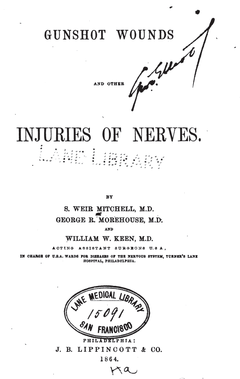- William Williams Keen
-
For other people named William Keen, see William Keen (disambiguation).
William Williams Keen 
Born January 19, 1837
PhiladelphiaDied June 7, 1932 (aged 95)
PhiladelphiaChildren Dora Keen (1871-1863)
Walter Jackson Freeman IRelatives Walter Jackson Freeman II, grandson William Williams Keen (January 19, 1837 – June 7, 1932) was the first brain surgeon in the United States. He also saw Franklin Delano Roosevelt when his paralytic illness struck, and worked closely with six American presidents.
Contents
Biography
Keen was born in Philadelphia on January 19, 1837. He attended Philadelphia Central High School.[1]
He studied at Brown University, where he graduated in 1859. He graduated in medicine from Jefferson Medical College in 1862. During the American Civil War, he worked for the U.S. Army as a surgeon. After the war, and two years of studies in Paris and Berlin.[1]
He married around 1870 and had as his children: Dora Keen, the Alpinist.
He started lecturing surgical pathology in Philadelphia. He was president of the Philadelphia School of Anatomy from 1875 to 1889.[1][2]
He became known in the medical community around the world for inventing several new procedures in brain surgery, including drainage of the cerebral ventricles and removals of large brain tumors. Keen also performed the first successful removal of a brain tumor.
Keen also participated in a secret surgical operation to remove a cancerous jaw tumor on Grover Cleveland in 1893.
Keen died in Philadelphia on June 7, 1932.[3]
Honors and recognition
He received honorary degrees from Jefferson Medical College and Brown, Northwestern, Toronto, Edinburgh, Yale, St. Andrews, Greifswald, and Upsala universities, and served as president of the American Surgical Association (1898), the American Medical Association (1900), the Congress of American Physicians and Surgeons (1903), and the American Philosophical Society (after 1907). New International Encyclopedia In 1914, at a meeting of the International Surgical Association, he was elected president for the meeting of 1917. After 1894 he was foreign corresponding member of the Société de Chirurgie de Paris, the Société Belge de Chirurgie, and the Clinical Society of London; honorary fellow of the Royal College of Surgeons of England, the Royal College of Surgeons of Edinburgh, the Deutsche Gesellschaft für Chirurgie, the Palermo Surgical Society, and the Berliner Medicinische Gesellschaft, and associate fellow of the American Academy of Arts and Sciences. New International Encyclopedia
Procedures and signs
- Keen's operation, an omphalectomy
- Keen's sign, increased diameter of the leg at the malleoli in Pott's fracture of the fibula.
Works
He published:
- Clinical Charts of the Human Body (1870)
- Early History of Practical Anatomy (1875)
- Surgical Complications and Sequels of Typhoid Fever (1898)
- Addresses and Other Papers (1905)
- Animal Experimentation and Medical Progress (1914)
- an edition of Heath's Practical Anatomy (1870)
- the New American from the Eleventh English Edition of Gray's Anatomy (Sept 1887) [4]
- the New American from the Thirteenth English Edition of Gray's Anatomy (Sept 1893) [4]
- the American Text-Book of Surgery (1899, 1903)
- Keen's System of Surgery (1905–13)
Co-authored:
- Gunshot Wounds, and Other Injuries of Nerves, together with Silas Weir Mitchell, George Read Morehouse (1864)
References
- ^ a b c "William Williams Keen". Jefferson Medical College. http://jeffline.jefferson.edu/SML/archives/exhibits/notable_alumni/william_keen.html. Retrieved 2010-07-31. "A graduate of Philadelphia's Central High School and Brown University (1859), Keen studied medicine at Jefferson Medical College and received his MD in 1862. Commissioned an acting Assistant Surgeon for the US Army, Keen's Civil War service centered on Turner's Lane Hospital in Philadelphia where he assisted S. Weir Mitchell. Eventually Keen's activity as a U.S. Army surgeon spanned the Civil War to World War I (his services were declined during the Spanish-American War). ..."
- ^ "Dr. Keen Reaches 90. Declares He Has No Formula for a Long Life". Associated Press in the New York Times. January 20, 1927. http://select.nytimes.com/gst/abstract.html?res=F20816F634591B728DDDA90A94D9405B878EF1D3. Retrieved 2010-07-31. "Dr. William W. Keen, internationally known surgeon and scientist, reached the age of 90 today and admitted he knows as little about how it happened as any layman. ... He conducted the Philadelphia School of Anatomy from ... was a lecturer on pathological anatomy at Jefferson. Professor of Artistic Anatomy at the ..."
- ^ "Dr. Keen, Famous Surgeon, Is Dead". Associated Press in the Milwaukee Sentinel. June 8, 1932. http://news.google.com/newspapers?id=rM8_AAAAIBAJ&sjid=MA4EAAAAIBAJ&pg=1787,1100241&dq=william+williams+keen&hl=en. Retrieved 2010-07-31. "Dr. William Williams Keen, who won world fame by his skill with the surgeon's knife, died at his home here Tuesday night from the ..."
- ^ a b Carmine D. Clemente, ed (1985). Gray’s Anatomy (30th ed.). Philadelphia: Lea & Febiger. ISBN 0-8121-0644-X. pp.vi-ix
External links
- Biography and pictures
- Gray's Anatomy: The Jefferson Years Scroll down page to find reference to W.W. Keen.
- William Williams Keen at Find a Grave
Categories:- 1837 births
- 1932 deaths
- People from Philadelphia, Pennsylvania
- American medical writers
- Brown University alumni
- American surgeons
- People of Pennsylvania in the American Civil War
- American Medical Association
- American Civil War surgeons
- Thomas Jefferson University alumni
- American Surgical Association members
Wikimedia Foundation. 2010.

